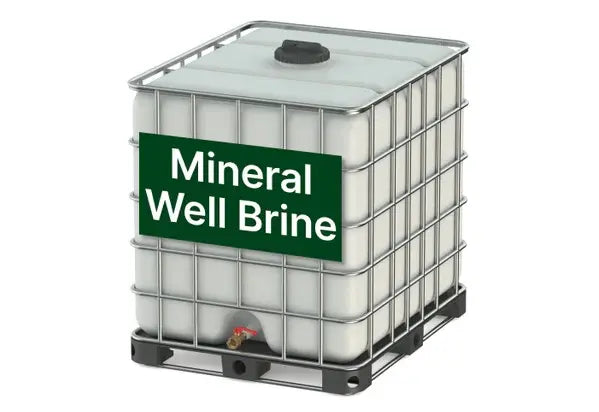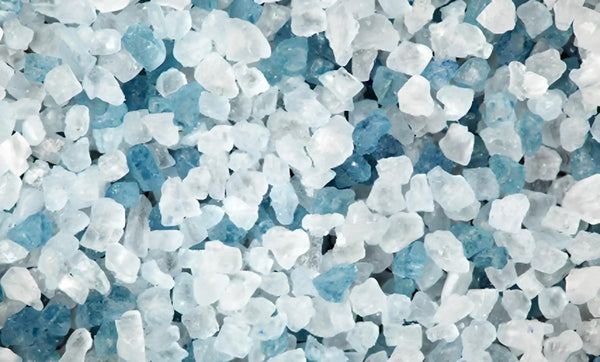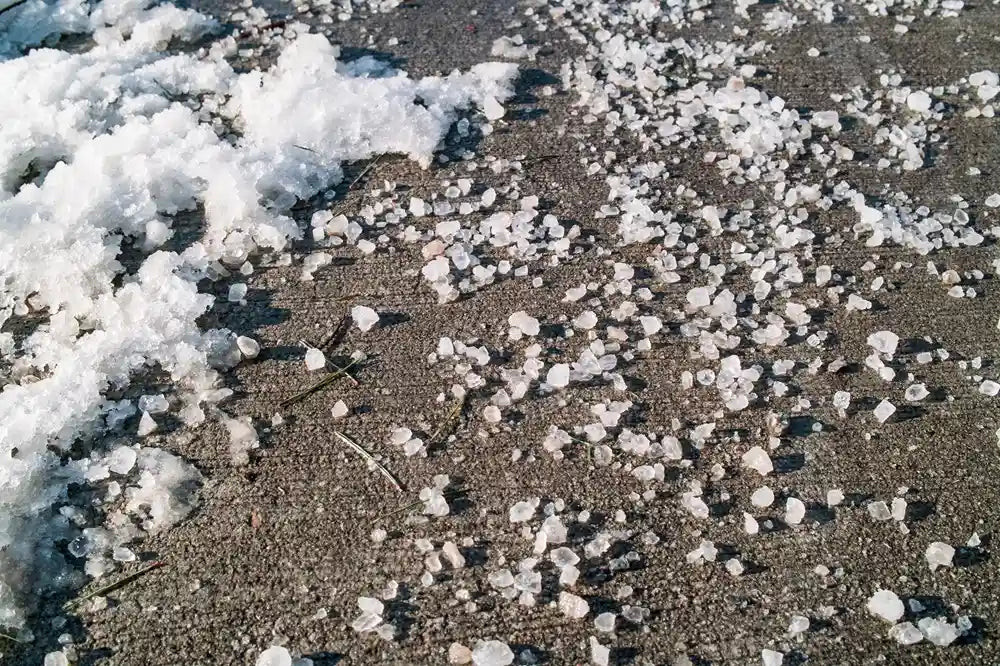Rock salt’s effectiveness diminishes as temperatures drop, impacting its ability to melt ice and snow, but at rockscapes.net, we can explore solutions for overcoming these limitations and ensure safe surfaces. Understanding the temperature thresholds of rock salt is crucial for effective winter maintenance, so keep reading to learn about alternative de-icing methods that can maintain optimal performance in colder conditions and enhance your winter landscape.
1. How Does Temperature Affect Rock Salt’s Performance?
Rock salt’s efficacy is heavily influenced by temperature; it stops working effectively around 20°F (-6°C). As the temperature dips lower, the amount of ice that rock salt can melt decreases dramatically. Rock salt, or sodium chloride, relies on a process called freezing point depression to melt ice. Salt dissolves in the thin layer of water that’s naturally present on ice surfaces. This creates a saltwater solution, which has a lower freezing point than pure water. As a result, the ice starts to melt.
Here’s a detailed look at how temperature impacts rock salt performance:
| Temperature (°F) | Approximate Ice Melted per Pound of Salt |
|---|---|
| 30°F (-1°C) | 46 pounds |
| 20°F (-7°C) | 8.6 pounds |
| 15°F (-9°C) | 6.3 pounds |
| 10°F (-12°C) | 4.9 pounds |
| 5°F (-15°C) | 4.1 pounds |
| 0°F (-18°C) | 3.7 pounds |
| -6°F (-21°C) | 3.2 pounds |
As you can see, the melting capacity of rock salt decreases significantly as temperatures fall below 20°F. This is because the process of dissolving salt and forming a brine solution slows down considerably in colder conditions. This slowdown is due to reduced kinetic energy; molecules move slower at lower temperatures, making it harder for the salt to dissolve and disrupt the ice’s structure.
 Rock Salt Performance Table
Rock Salt Performance Table
2. What Happens When Rock Salt Is Used Below Its Effective Temperature?
When rock salt is used below its effective temperature, typically around 20°F (-6°C), it becomes significantly less efficient at melting ice. Instead of quickly dissolving and creating a brine solution to lower the freezing point of water, the salt granules remain largely inactive on the ice surface. The chemical reaction slows down, and the already limited amount of liquid water available at these temperatures struggles to dissolve the salt effectively.
This results in several noticeable consequences:
- Reduced Melting: The most immediate effect is a drastic reduction in the amount of ice melted.
- Slower Action: Even if some melting occurs, the process is significantly slower.
- Wasted Salt: A large portion of the applied salt remains unused. This leads to economic inefficiencies, as you’re using more product to achieve less result.
- Environmental Concerns: Unmelted salt can be washed away into the environment. This contributes to soil salinization and potential harm to vegetation.
- Safety Issues: The persistence of ice and snow despite salt application poses safety hazards for pedestrians and vehicles.
According to research from Arizona State University’s School of Earth and Space Exploration, the efficiency of de-icing salts decreases exponentially as temperatures drop below freezing.
3. What Are the Alternatives to Rock Salt in Cold Weather?
When rock salt becomes ineffective due to low temperatures, several alternatives can be used to maintain safe surfaces:
- Calcium Chloride: Calcium chloride is effective down to -25°F (-32°C). It generates heat as it dissolves, which helps to melt ice more quickly. However, it can be more expensive than rock salt.
- Magnesium Chloride: Magnesium chloride works well down to 5°F (-15°C). It is less corrosive than calcium chloride and is often used in environmentally sensitive areas.
- Potassium Chloride: Potassium chloride is effective down to 20°F (-7°C), similar to rock salt. It is less corrosive than sodium chloride but also less effective at lower temperatures.
- Urea: Urea is a nitrogen-based compound that can melt ice. It is less corrosive and safer for vegetation but is also less effective at lower temperatures.
- Sand: Sand does not melt ice but provides traction, making surfaces less slippery. It is an inexpensive option but requires cleanup after the weather clears.
- Gravel: Similar to sand, gravel provides traction and is useful in areas where melting is not feasible. It also requires cleanup.
| De-Icing Alternative | Effective Temperature | Pros | Cons |
|---|---|---|---|
| Calcium Chloride | -25°F (-32°C) | Melts ice quickly, generates heat | More expensive, can be corrosive |
| Magnesium Chloride | 5°F (-15°C) | Less corrosive, environmentally friendly | Less effective at very low temperatures |
| Potassium Chloride | 20°F (-7°C) | Less corrosive than sodium chloride | Similar effectiveness to rock salt |
| Urea | Varies | Less corrosive, safer for vegetation | Less effective at low temperatures |
| Sand | N/A | Provides traction, inexpensive | Does not melt ice, requires cleanup |
| Gravel | N/A | Provides traction, useful where melting is not feasible | Does not melt ice, requires cleanup |
Choosing the right alternative depends on the specific temperature conditions, environmental concerns, and budget considerations.
4. How Do Liquid De-Icers Enhance Ice Melting?
Liquid de-icers are highly effective at enhancing ice melting, particularly in cold weather conditions, due to their unique application and chemical properties.
Here’s how liquid de-icers improve ice melting:
- Pre-Wetting: Liquid de-icers are often applied before a snow or ice event. This process, known as pre-wetting, prevents the initial bonding of snow and ice to the pavement.
- Even Distribution: Liquid de-icers ensure uniform coverage over the surface. This consistent application maximizes the contact area between the de-icer and the ice, leading to faster and more efficient melting.
- Lower Freezing Point: The additives in liquid de-icers, such as magnesium chloride or calcium chloride, lower the freezing point of water more effectively than rock salt alone.
- Adhesion: Liquid de-icers adhere better to the pavement surface compared to solid rock salt. This reduces bounce and scatter, ensuring that the de-icer stays in place and continues to work.
- Faster Activation: Liquid de-icers begin working almost immediately upon application. The liquid form allows for faster chemical reactions and quicker melting, especially critical during rapidly changing weather conditions.
- Reduced Corrosion: Some liquid de-icers contain corrosion inhibitors that reduce the corrosive effects on vehicles and infrastructure.
According to the Salt Institute, pre-wetting with liquid de-icers can reduce the amount of solid de-icer needed by as much as 30%, while also speeding up the melting process.
 Use a Liquid De-Icer
Use a Liquid De-Icer
5. What Is Treated or Enhanced Rock Salt?
Treated or enhanced rock salt is conventional rock salt (sodium chloride) that has been modified with liquid additives to improve its performance, especially in colder temperatures. The additives typically include magnesium chloride, calcium chloride, or organic-based performance enhancers (OBPE). These enhancements alter the physical and chemical properties of the salt, resulting in several benefits:
- Lower Effective Temperature: Treated rock salt can work effectively at temperatures significantly lower than regular rock salt.
- Faster Melting: The additives help the salt dissolve more quickly. This initiates the melting process faster than untreated salt.
- Reduced Bounce and Scatter: The liquid additives create a stickier surface, reducing the amount of salt that bounces or scatters off the pavement.
- Corrosion Inhibition: Some treated salts include corrosion inhibitors to minimize the harmful effects of salt on vehicles and infrastructure.
- Environmental Benefits: Enhanced rock salt often requires less product to achieve the same level of ice melting, which reduces the overall environmental impact.
- Visual Indication: Many treated salts are dyed with biodegradable colors. This provides a visual indication of where the salt has been applied.
According to a study by the Clear Roads research program, treated salt can improve ice melting performance by up to 30% at temperatures below 20°F compared to regular rock salt.
 Benefit from Treated Rock Salt
Benefit from Treated Rock Salt
6. What Are Organic-Based Performance Enhancers (OBPE) in Treated Rock Salt?
Organic-Based Performance Enhancers (OBPE) are additives derived from natural sources, such as agricultural byproducts like corn, beets, or molasses. They are used in treated rock salt to enhance its performance, particularly at lower temperatures. OBPEs offer several benefits:
- Enhanced Melting: OBPEs help to accelerate the melting process by improving the salt’s ability to dissolve ice and snow.
- Lower Freezing Point: These enhancers can further reduce the freezing point of the salt brine solution. This allows the treated salt to remain effective at colder temperatures.
- Improved Adhesion: OBPEs increase the stickiness of the salt. This reduces bounce and scatter upon application, ensuring the salt stays in place.
- Corrosion Inhibition: Some OBPEs act as natural corrosion inhibitors. This helps to minimize the harmful effects of salt on vehicles and infrastructure.
- Environmental Benefits: Being derived from renewable resources, OBPEs are biodegradable and have a lower environmental impact compared to some chemical additives.
The Pacific Northwest Snowfighters (PNS) association has conducted extensive testing on various de-icing products and found that OBPEs can significantly improve the performance and environmental profile of treated rock salt.
7. How Does Pre-Treating Roads with Salt Brine Work?
Pre-treating roads with salt brine involves applying a liquid solution of salt (sodium chloride) and water to the road surface before a snow or ice event. This proactive approach helps to prevent the formation of a strong bond between the snow/ice and the pavement, making it easier to clear the roads once the storm hits. The process works through several mechanisms:
- Prevention of Bonding: The salt brine creates a thin layer of saltwater on the pavement. This prevents snow and ice from directly adhering to the surface.
- Disruption of Ice Crystal Formation: The salt in the brine interferes with the formation of ice crystals. This results in a softer, more easily removable layer of ice or snow.
- Faster Melting: When snow or ice does accumulate, the presence of salt brine accelerates the melting process from the start.
- Reduced Ice Accumulation: By preventing a strong bond and promoting faster melting, pre-treating reduces the overall accumulation of ice and snow on the road surface.
- Cost-Effectiveness: Pre-treating can reduce the amount of solid de-icer needed during and after the storm.
- Improved Safety: By maintaining clearer roads, pre-treating enhances safety for drivers and pedestrians.
According to the Federal Highway Administration (FHWA), pre-treating roads with salt brine can reduce the overall costs of winter road maintenance by as much as 40%.
8. What Equipment Is Needed for Effective De-Icing?
Effective de-icing requires the right equipment to ensure proper application and coverage. Here’s a list of essential equipment:
- Salt Spreaders: These are used to distribute solid de-icing materials like rock salt, calcium chloride, or treated salt.
- Liquid De-Icer Sprayers: These spray liquid de-icers, such as salt brine or magnesium chloride solutions, onto surfaces.
- Pre-Wetting Systems: These systems are attached to salt spreaders to pre-wet solid de-icers as they are applied.
- Snowplows: Snowplows clear heavy accumulations of snow before or after de-icing.
- Ice Scrapers: Handheld ice scrapers are useful for removing ice from smaller areas, such as sidewalks or steps.
- Thermometers: Monitoring surface and air temperatures helps determine the most effective de-icing strategy.
- Storage Facilities: Proper storage is needed to keep de-icing materials dry and ready for use.
The type and scale of equipment needed depend on the size of the area to be de-iced and the severity of winter weather conditions.
9. How Do You Store Rock Salt Properly?
Proper storage of rock salt is essential to maintain its effectiveness and prevent caking or clumping. Here are some guidelines for storing rock salt:
- Dry Location: Store rock salt in a dry location to prevent moisture absorption, which can cause clumping.
- Covered Storage: Keep the salt covered with a tarp or in a shed to protect it from rain and snow.
- Elevated Platform: Store salt on a wooden pallet or elevated platform to prevent ground moisture from seeping into the pile.
- Well-Ventilated Area: Ensure the storage area is well-ventilated to reduce humidity and condensation.
- Avoid Contamination: Keep the salt away from contaminants such as dirt, debris, or other chemicals.
- Regular Inspection: Periodically inspect the salt for any signs of clumping or contamination.
According to the Strategic Highway Research Program (SHRP), proper storage can extend the shelf life of rock salt indefinitely.
10. What Are the Environmental Impacts of Using Rock Salt?
While rock salt is effective for de-icing, its use can have several environmental impacts:
- Soil Salinization: Salt runoff can contaminate soil, increasing its salinity and harming vegetation.
- Water Contamination: Salt can leach into groundwater and surface water, affecting aquatic ecosystems and drinking water sources.
- Corrosion: Salt accelerates the corrosion of vehicles, bridges, and other infrastructure.
- Harm to Wildlife: Salt can be toxic to wildlife, particularly amphibians and birds.
- Vegetation Damage: Salt spray can damage or kill roadside vegetation, affecting plant health and biodiversity.
According to the Environmental Protection Agency (EPA), minimizing salt use and implementing best management practices can help mitigate these environmental impacts.
By understanding the limitations of rock salt and exploring alternative methods, you can maintain safe and beautiful landscapes even in the harshest winter conditions. For more innovative solutions and expert advice, visit rockscapes.net, where you can discover a wide range of products and strategies to enhance your winter landscape and explore our selection of decorative gravel, landscape rocks, and drainage solutions.
FAQ: What Temperature Does Rock Salt Stop Working?
1. At what specific temperature does rock salt become ineffective?
Rock salt typically becomes ineffective around 20°F (-6°C).
2. Why does rock salt stop working at low temperatures?
The chemical process required for melting ice slows down significantly at lower temperatures.
3. What is the main component of rock salt?
The main component of rock salt is sodium chloride.
4. Are there alternatives to rock salt that work at lower temperatures?
Yes, alternatives like calcium chloride and magnesium chloride are effective at lower temperatures.
5. How does calcium chloride compare to rock salt in terms of effectiveness?
Calcium chloride is more effective at lower temperatures than rock salt.
6. What makes magnesium chloride a good alternative to rock salt?
Magnesium chloride is less corrosive and environmentally friendlier than rock salt.
7. Can treated rock salt work at temperatures lower than regular rock salt?
Yes, treated rock salt can be effective at temperatures lower than regular rock salt.
8. What are Organic-Based Performance Enhancers (OBPE) and how do they help?
OBPEs are natural additives that enhance melting and reduce bounce and scatter of rock salt.
9. How does pre-treating roads with salt brine help in managing ice?
Pre-treating prevents ice from bonding to the pavement, making it easier to clear roads.
10. What should I consider when choosing a de-icing method?
Consider the temperature conditions, environmental concerns, and budget when choosing a de-icing method.
